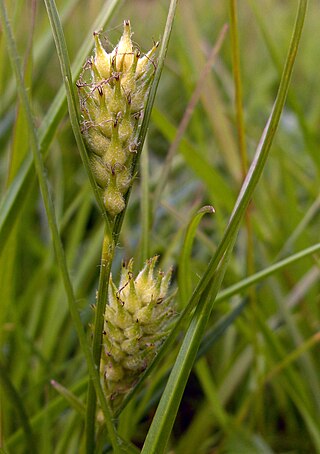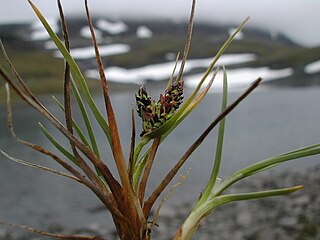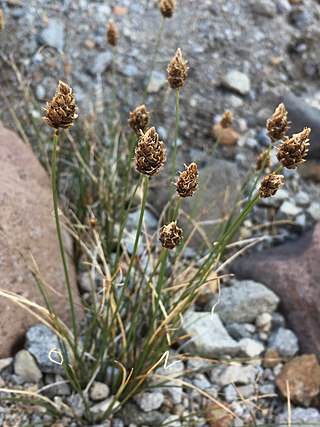Related Research Articles

The Cyperaceae are a family of graminoid (grass-like), monocotyledonous flowering plants known as sedges. The family is large, with some 5,500 known species described in about 90 genera, the largest being the "true sedges" genus Carex with over 2,000 species.

Carex is a vast genus of more than 2,000 species of grass-like plants in the family Cyperaceae, commonly known as sedges. Other members of the family Cyperaceae are also called sedges, however those of genus Carex may be called true sedges, and it is the most species-rich genus in the family. The study of Carex is known as caricology.
Douglas Barton Osborne Savile was an Irish-born Canadian mycologist, plant pathologist and evolutionary biologist. He is particularly renowned for his unique work on the coevolution of host plants and their rust fungi.

Carex chordorrhiza, commonly called creeping sedge or string sedge, is a species of perennial plant in the family Cyperaceae with Holarctic distribution growing in acidic bogs.

Carex nigra is a perennial species of plants in the family Cyperaceae native to wetlands of Europe, western Asia, north Africa, and eastern North America. Common names include common sedge, black sedge or smooth black sedge. The eastern limit of its range reaches central Siberia, Turkey and probably the Caucasus.

Carex siderosticta is a species of sedge native to East Asia. It is the only species of Carex known to produce "pseudo-lateral" culms, which appear to be lateral, but derive from the apical meristem. It is the type species of Carex subg. Siderosticta.

Carex hirta, the hairy sedge or hammer sedge, is a species of sedge native across Europe. It has characteristic hairy leaves and inflorescences, and is the type species of the genus Carex.

Carex sect. Spirostachyae is a section of the genus Carex, containing 38 species of sedge. Species in Carex sect. Spirostachyae share a suite of features, including the short internodes of the primary rhizomes, the presence of an antiligule, the leaf-like, sheathing bract at the base of the inflorescence, the presence of three stigmas in female flowers, and the shape of the seeds.

Carex bigelowii is a species of sedge known by the common names Bigelow's sedge, Gwanmo sedge, and stiff sedge. It has an Arctic–alpine distribution in Eurasia and North America, and grows up to 50 centimetres (20 in) tall in a variety of habitats.

Carex rufina is a species of sedge known by the common name snowbed sedge. It is native to Denmark, Norway, Sweden, Greenland, and northeastern Canada.
Carex porrecta is a plant species known from Costa Rica, Colombia, Venezuela and Ecuador. It is found in humid forests at elevations of 1,600–2,600 metres (5,200–8,500 ft).

Carex breweri, known as Brewer's sedge, is a species of sedge that grows on dry rocky or gravel slopes in the Sierra Nevada and Cascade Mountains of the western United States, as far north as Mount Hood. It is classified in Carex sect. Inflatae, alongside Carex engelmannii and Carex subnigricans.

Carex kobomugi is a species of sedge, known as the Japanese sedge or Asiatic sand sedge, that lives in sandy coastal areas of eastern Asia, and has become an invasive species in the north-eastern United States.

Carex rosea, the rosy sedge, is a flowering plant and part of the family Cyperaceae. Synonyms for Carex rosea include Carex concoluta, and Carex flaccidula. It is native to central and eastern North America and it exists in wet to dry soils. Carex rosea can be found in shores of streams and bottomlands, as well as ponds. It is known to have good adaptations to dry-shade locations. It is an evergreen plant which is easy to grow.

Carex viridula, known as little green sedge, green sedge, or greenish sedge, is a small flowering plant native to North America, Europe, Asia, and Morocco.

Carex juniperorum, the juniper sedge, is a perennial flowering plant native to North America, first described by botanist William J. Crins in 1993. C. juniperorum is in the Cyperaceae (sedge) family, and is closely related to C. jamesii and C. willdenowii. It is commonly called juniper sedge as it is often seen growing in areas with red cedar, though the presence of cedar is not necessarily a requirement for it to grow.

Carex baileyi is a sedge in section Vesicariae the genus Carex native to the Appalachian mountains in Eastern North America. It is commonly called Bailey's sedge. Carex baileyi was named in honor of Liberty Hyde Bailey by its discoverer, Nathaniel_Lord_Britton.
William "Bill" J. Crins is a botanist, naturalist, and ecologist.

Carex appalachica, the Appalachian sedge, is a species of flowering plant in the family Cyperaceae, native to the Appalachian Mountains of the United States and Canada. It is a member of the Carex rosea species group.
Carex missouriensis is a species of sedge in the family Cyperaceae, native to the US states of Nebraska, Kansas, Iowa, Missouri, Illinois, and Indiana. It is typically found in swales in surviving patches of prairie.
References
- 1 2 3 4 "Ball, Peter William (1932-)". JSTOR Global Plants.
- ↑ Prime, Cecil Thomas; Deacock, Richard John (1948). The Shorter British Flora. Methuen and Company.
- ↑ "Peter William Ball". Botanical Society of Britain & Ireland.
- ↑ International Plant Names Index. P.W.Ball.